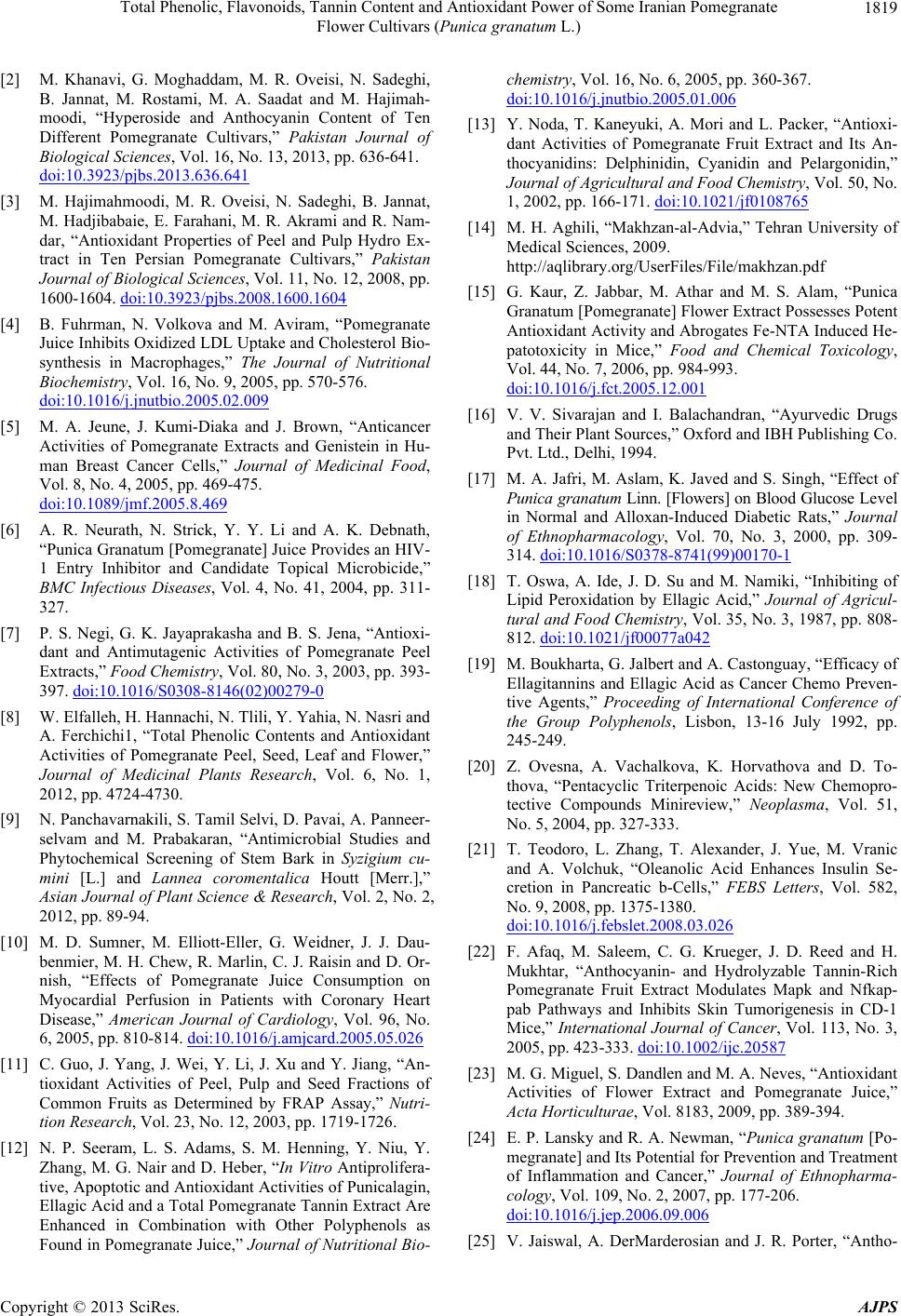
Total Phenolic, Flavonoids, Tannin Content and Antioxidant Power of Some Iranian Pomegranate
Flower Cultivars (Punica granatum L.)
1819
[2] M. Khanavi, G. Moghaddam, M. R. Oveisi, N. Sadeghi,
B. Jannat, M. Rostami, M. A. Saadat and M. Hajimah-
moodi, “Hyperoside and Anthocyanin Content of Ten
Different Pomegranate Cultivars,” Pakistan Journal of
Biological Sciences, Vol. 16, No. 13, 2013, pp. 636-641.
doi:10.3923/pjbs.2013.636.641
[3] M. Hajimahmoodi, M. R. Oveisi, N. Sadeghi, B. Jannat,
M. Hadjibabaie, E. Farahani, M. R. Akrami and R. Nam-
dar, “Antioxidant Properties of Peel and Pulp Hydro Ex-
tract in Ten Persian Pomegranate Cultivars,” Pakistan
Journal of Biological Sciences, Vol. 11, No. 12, 2008, pp.
1600-1604. doi:10.3923/pjbs.2008.1600.1604
[4] B. Fuhrman, N. Volkova and M. Aviram, “Pomegranate
Juice Inhibits Oxidized LDL Uptake and Cholesterol Bio-
synthesis in Macrophages,” The Journal of Nutritional
Biochemistry, Vol. 16, No. 9, 2005, pp. 570-576.
doi:10.1016/j.jnutbio.2005.02.009
[5] M. A. Jeune, J. Kumi-Diaka and J. Brown, “Anticancer
Activities of Pomegranate Extracts and Genistein in Hu-
man Breast Cancer Cells,” Journal of Medicinal Food,
Vol. 8, No. 4, 2005, pp. 469-475.
doi:10.1089/jmf.2005.8.469
[6] A. R. Neurath, N. Strick, Y. Y. Li and A. K. Debnath,
“Punica Granatum [Pomegranate] Juice Provides an HIV-
1 Entry Inhibitor and Candidate Topical Microbicide,”
BMC Infectious Diseases, Vol. 4, No. 41, 2004, pp. 311-
327.
[7] P. S. Negi, G. K. Jayaprakasha and B. S. Jena, “Antioxi-
dant and Antimutagenic Activities of Pomegranate Peel
Extracts,” Food Chemistry, Vol. 80, No. 3, 2003, pp. 393-
397. doi:10.1016/S0308-8146(02)00279-0
[8] W. Elfalleh, H. Hannachi, N. Tlili, Y. Yahia, N. Nasri and
A. Ferchichi1, “Total Phenolic Contents and Antioxidant
Activities of Pomegranate Peel, Seed, Leaf and Flower,”
Journal of Medicinal Plants Research, Vol. 6, No. 1,
2012, pp. 4724-4730.
[9] N. Panchavarnakili, S. Tamil Selvi, D. Pavai, A. Panneer-
selvam and M. Prabakaran, “Antimicrobial Studies and
Phytochemical Screening of Stem Bark in Syzigium cu-
mini [L.] and Lannea coromentalica Houtt [Merr.],”
Asian Journal of Plant Science & Research, Vol. 2, No. 2,
2012, pp. 89-94.
[10] M. D. Sumner, M. Elliott-Eller, G. Weidner, J. J. Dau-
benmier, M. H. Chew, R. Marlin, C. J. Raisin and D. Or-
nish, “Effects of Pomegranate Juice Consumption on
Myocardial Perfusion in Patients with Coronary Heart
Disease,” American Journal of Cardiology, Vol. 96, No.
6, 2005, pp. 810-814. doi:10.1016/j.amjcard.2005.05.026
[11] C. Guo, J. Yang, J. Wei, Y. Li, J. Xu and Y. Jiang, “An-
tioxidant Activities of Peel, Pulp and Seed Fractions of
Common Fruits as Determined by FRAP Assay,” Nutri-
tion Research, Vol. 23, No. 12, 2003, pp. 1719-1726.
[12] N. P. Seeram, L. S. Adams, S. M. Henning, Y. Niu, Y.
Zhang, M. G. Nair and D. Heber, “In Vitro Antiprolifera-
tive, Apoptotic and Antioxidant Activities of Punicalagin,
Ellagic Acid and a Total Pomegranate Tannin Extract Are
Enhanced in Combination with Other Polyphenols as
Found in Pomegranate Juice,” Journal of Nutritional Bio-
chemistry, Vol. 16, No. 6, 2005, pp. 360-367.
doi:10.1016/j.jnutbio.2005.01.006
[13] Y. Noda, T. Kaneyuki, A. Mori and L. Packer, “Antioxi-
dant Activities of Pomegranate Fruit Extract and Its An-
thocyanidins: Delphinidin, Cyanidin and Pelargonidin,”
Journal of Agricultural and Food Chemistry, Vol. 50, No.
1, 2002, pp. 166-171. doi:10.1021/jf0108765
[14] M. H. Aghili, “Makhzan-al-Advia,” Tehran University of
Medical Sciences, 2009.
http://aqlibrary.org/UserFiles/File/makhzan.pdf
[15] G. Kaur, Z. Jabbar, M. Athar and M. S. Alam, “Punica
Granatum [Pomegranate] Flower Extract Possesses Potent
Antioxidant Activity and Abrogates Fe-NTA Induced He-
patotoxicity in Mice,” Food and Chemical Toxicology,
Vol. 44, No. 7, 2006, pp. 984-993.
doi:10.1016/j.fct.2005.12.001
[16] V. V. Sivarajan and I. Balachandran, “Ayurvedic Drugs
and Their Plant Sources,” Oxford and IBH Publishing Co.
Pvt. Ltd., Delhi, 1994.
[17] M. A. Jafri, M. Aslam, K. Javed and S. Singh, “Effect of
Punica granatum Linn. [Flowers] on Blood Glucose Level
in Normal and Alloxan-Induced Diabetic Rats,” Journal
of Ethnopharmacology, Vol. 70, No. 3, 2000, pp. 309-
314. doi:10.1016/S0378-8741(99)00170-1
[18] T. Oswa, A. Ide, J. D. Su and M. Namiki, “Inhibiting of
Lipid Peroxidation by Ellagic Acid,” Journal of Agricul-
tural and Food Chemistry, Vol. 35, No. 3, 1987, pp. 808-
812. doi:10.1021/jf00077a042
[19] M. Boukharta, G. Jalbert and A. Castonguay, “Efficacy of
Ellagitannins and Ellagic Acid as Cancer Chemo Preven-
tive Agents,” Proceeding of International Conference of
the Group Polyphenols, Lisbon, 13-16 July 1992, pp.
245-249.
[20] Z. Ovesna, A. Vachalkova, K. Horvathova and D. To-
thova, “Pentacyclic Triterpenoic Acids: New Chemopro-
tective Compounds Minireview,” Neoplasma, Vol. 51,
No. 5, 2004, pp. 327-333.
[21] T. Teodoro, L. Zhang, T. Alexander, J. Yue, M. Vranic
and A. Volchuk, “Oleanolic Acid Enhances Insulin Se-
cretion in Pancreatic b-Cells,” FEBS Letters, Vol. 582,
No. 9, 2008, pp. 1375-1380.
doi:10.1016/j.febslet.2008.03.026
[22] F. Afaq, M. Saleem, C. G. Krueger, J. D. Reed and H.
Mukhtar, “Anthocyanin- and Hydrolyzable Tannin-Rich
Pomegranate Fruit Extract Modulates Mapk and Nfkap-
pab Pathways and Inhibits Skin Tumorigenesis in CD-1
Mice,” International Journal of Cancer, Vol. 113, No. 3,
2005, pp. 423-333. doi:10.1002/ijc.20587
[23] M. G. Miguel, S. Dandlen and M. A. Neves, “Antioxidant
Activities of Flower Extract and Pomegranate Juice,”
Acta Horticulturae, Vol. 8183, 2009, pp. 389-394.
[24] E. P. Lansky and R. A. Newman, “Punica granatum [Po-
megranate] and Its Potential for Prevention and Treatment
of Inflammation and Cancer,” Journal of Ethnopharma-
cology, Vol. 109, No. 2, 2007, pp. 177-206.
doi:10.1016/j.jep.2006.09.006
[25] V. Jaiswal, A. DerMarderosian and J. R. Porter, “Antho-
Copyright © 2013 SciRes. AJPS